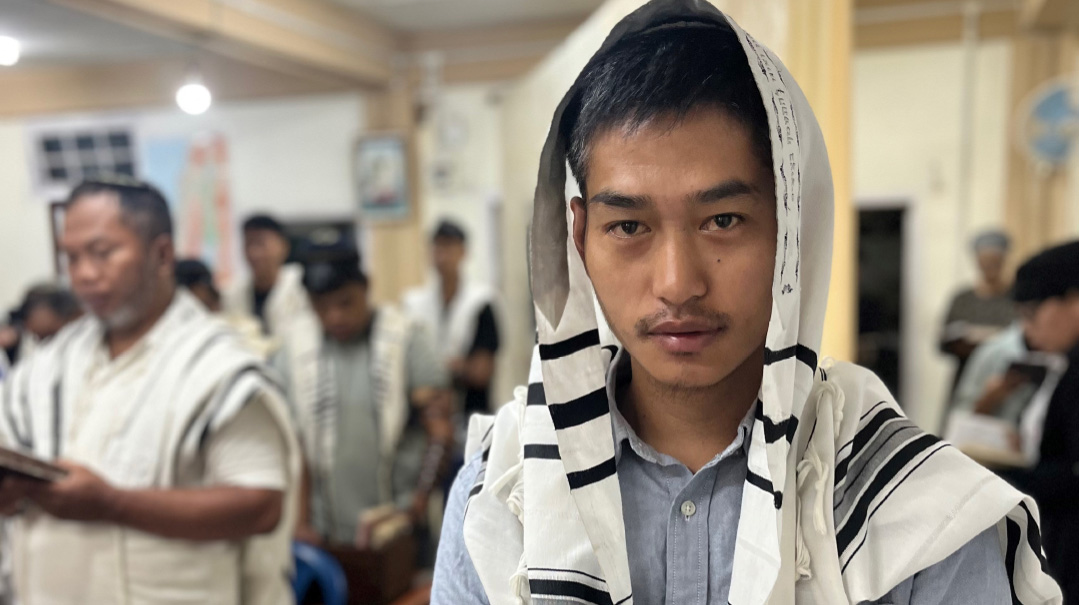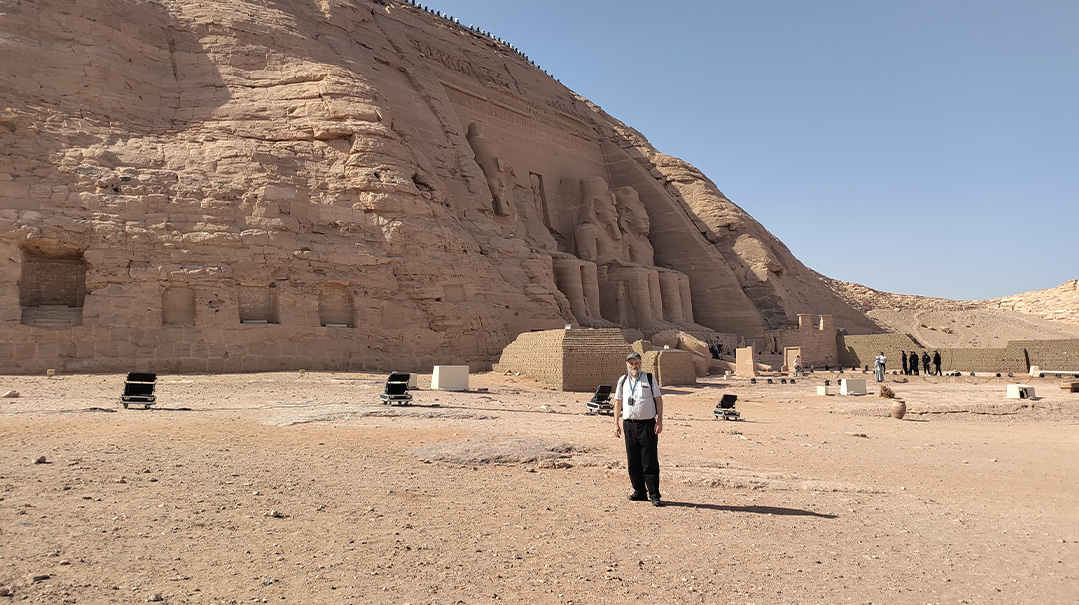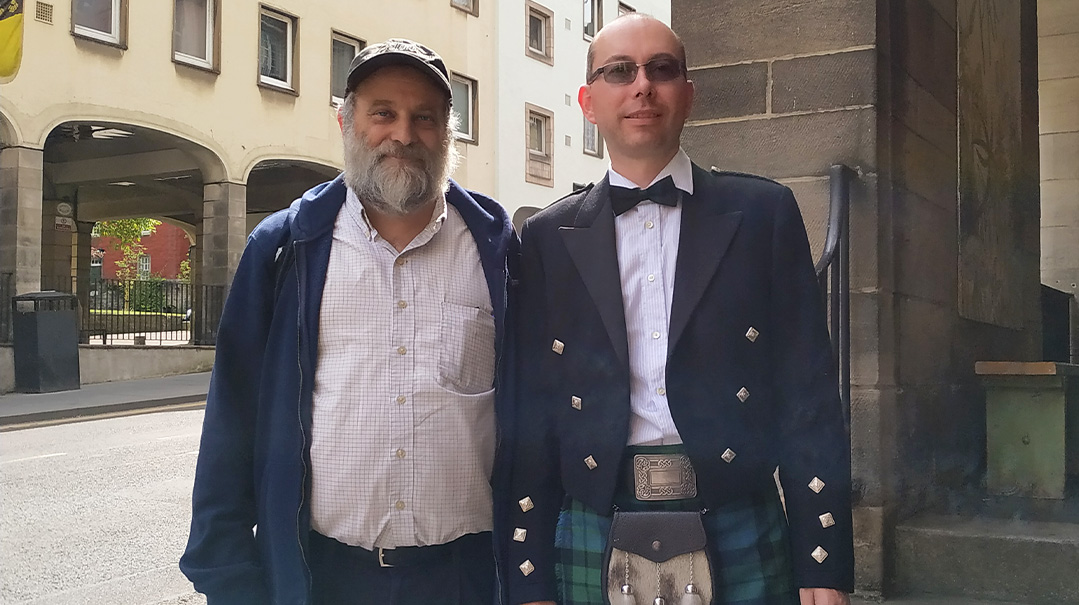TRIBES LOST AND FOUND
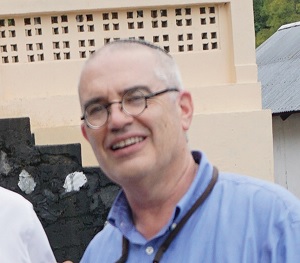
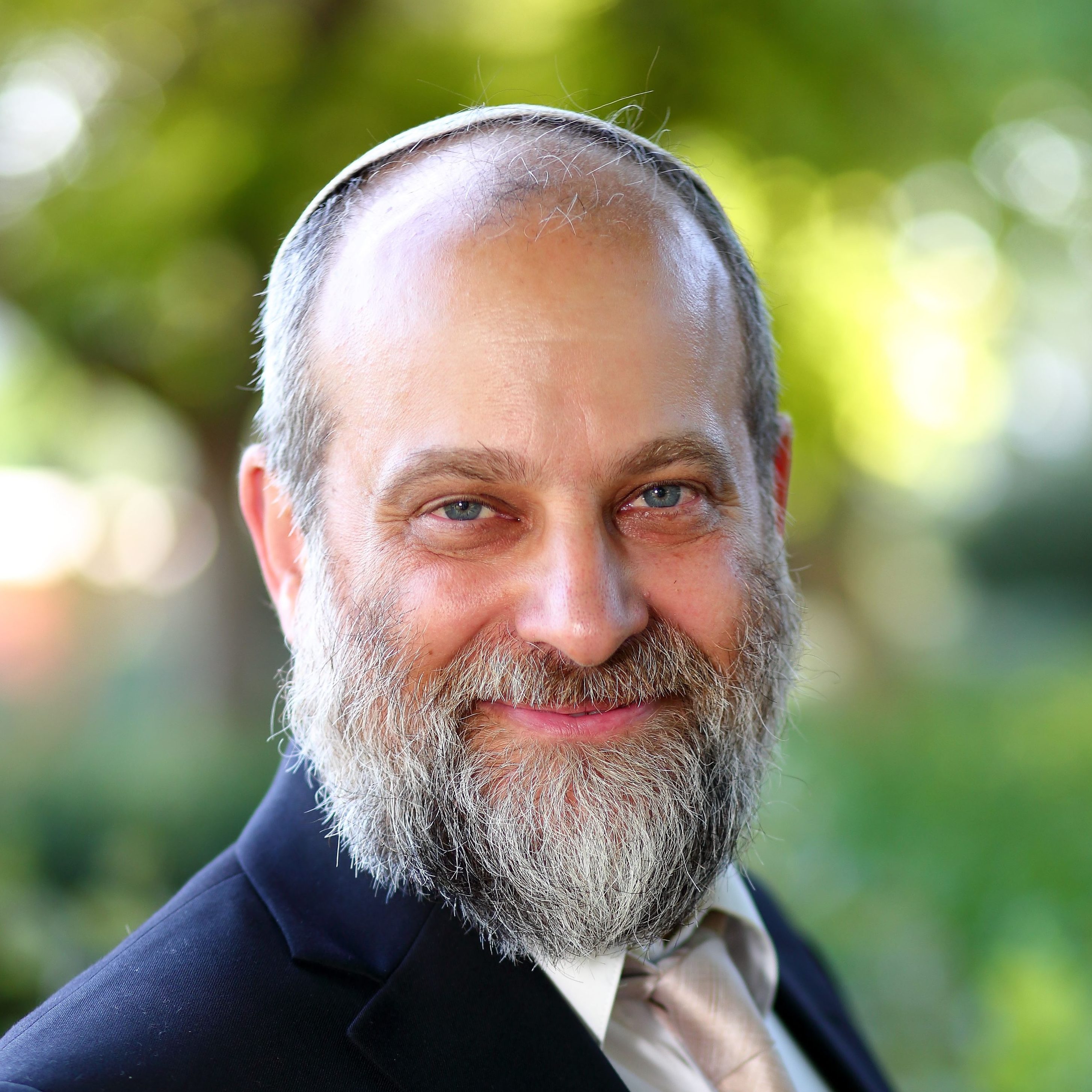
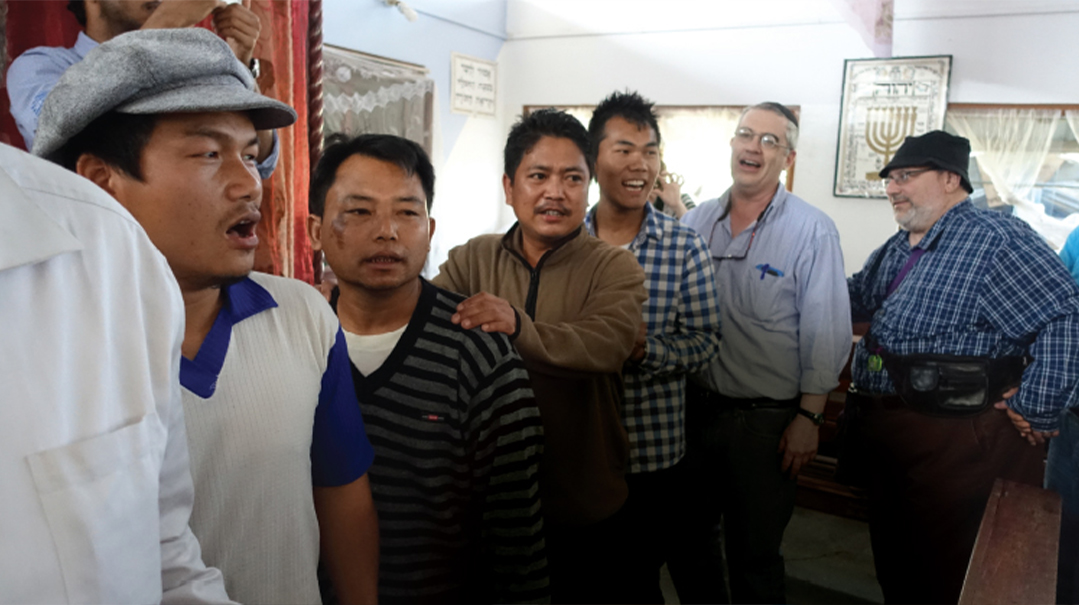
We knocked and waited nervously because we hadn’t notified them ahead — yet we weren’t disappointed. As the door opened to the little hut, a kippah-clad man smiled broadly and said, “Baruch haba!” He led us through a courtyard to a small, well-kept synagogue. We were not in Monsey, but in a far-flung corner of India on the northeastern border state of Manipur, preparing the ground in advance of our curious delegation — a party of 35 Western Jews and one of the rare groups to visit this little-known Indian community known as the Bnei Menashe.
We were both excited and relieved by the warm welcome, as their story is exotic and spans thousands of years of Jewish history. It is a direct link with our Biblical past and raises interesting halachic and philosophic conundrums about our future. Welcome to our search for part of the Ten Lost Tribes.
It all started with a call from the OU Israel Center inviting us to lead a “Halachic Adventure” tour. We asked the organizers where they would like to go, and they replied, “Where would you like to lead us?” The answer for us was simple: to return to India where the richness and diversity of Jewish history is largely unknown to much of the Jewish world.
Our goal was to give our fellow adventurers a unique, exciting, and off-the-beaten-track experience. However, taking a group of 35 people is very different from our typical “Mesorah Quest” — our usual method of travel when we’re on our own: we make critical contacts, hop on a plane with a few cans of tuna, and show up for a whirlwind visit in which we meet and really get to know the local individuals. Sometimes we have to adjust our plans at the last minute.
So the logistics of being responsible for such a large group and knowing we’d surely encounter unscripted adventures along the way made us a little nervous, but in the end, baruch Hashem, things worked out even better than we could have dreamed. Our group got to see the backwaters of India and visit the communities of Bene Israel and the Jews of Cochin (we reported on all that over the past year). And while many people have come across Bnei Menashe halachic converts in Israel, seeing their ancient communities on the ground was a special treat for both us and our newest group of halachic adventurers.
Lost Forever?
The Bnei Menashe have no written history, but their oral tradition tells of their ancestor “Menasia,” who is understood to be Menashe, son of Yaakov Avinu and patriarch of the tribe that settled on both banks of the Jordan River. But then, together with the other tribes of the biblical Northern Kingdom who were defeated by the Assyrians 130 years before the destruction of the First Beis Hamikdash, all of Menashe was exiled as part of the dispersion of the Ten Tribes. What happened to them, where did they go, and are they lost forever? Have some begun to return? Our recent trip to India provided some answers and raised many questions as well.
We are told “And the G-d of Israel stirred up the spirit of Pul, king of Assyria, and the spirit of Tilgath-Pilneser, king of Assyria, and he carried them away, even the Reubenites and the Gadites, and half the tribe of Manasseh, and brought them unto Halah, and Habor, and Harah, and to the river Gozan unto this day” (I Chronicles 5:26). The Gemara (Sanhedrin 94a) attempts to identify these locations and suggests either someplace in Africa or the mountains of Afghanistan. The Gemara knew of the existence of the dispersed Ten Tribes, as Rav Assi in third-century Bavel (about 900 years after the Northern Kingdom had been exiled) stated regarding a non-Jew who is mekadesh a Jewish woman, that we are concerned about whether it is a valid kiddushin, for perhaps he is from the Ten Tribes and is therefore really Jewish (Yevamos 16b). The Gemara explains that Rav Assi is referring to a locale where it was known that some of the Ten Tribes lived in their day. Clearly, as late as the third century, Chazal were still aware of areas that had a tradition of the dispersion of these tribes. Even in the 19th century — 1,600 years later — Polish acharon Rav Yisrael Lipschitz (Yachin on Sanhedrin 10:3) describes the Lost Tribes as being in India and Abyssinia.
Escape to the East
Community members describe their history, recounting how after being exiled and enslaved by the Assyrians, they escaped, pushing eastward through Afghanistan into Tibet, and then to central and southern China where for many years they lived in relative peace and maintained a form of Jewish practice. At some point they began to be oppressed, and say that their “leather scrolls” were burned. They ultimately fled central China where they hid in caves (and thus are also called the “Shinlung” or “cave-dwellers”) and eventually moved to present day Burma and India. In the1800s, some of them moved on to Manipur and Mizoram in eastern India, where they still live today.
In the ensuing years though, Christian missionaries overwhelmed the area, making it difficult for the Bnei Menashe to maintain much Jewish identity. On the other hand, when the missionaries reintroduced them to the Bible at the end of the 19th century, the Bnei Menashe noticed parallels between ancient Jewish customs and their oral traditions, reinforcing their historical legend of being of Jewish origin. Some of these customs included animal sacrifices, yibum, burial of the dead, draining the blood from an animal before eating it, and not traveling out of their domain on Shabbos. In the 1970s, when they finally became aware that there were other Jewish communities in India, some tried sending their children to Jewish schools in Bombay.
The return of the Bnei Menashe began in earnest in 1979 when they wrote a letter to Rabbi Eliyahu Avichail, who headed Amishav, an organization “which assisted Jews in far-flung lands.” Rabbi Avichail, who was niftar this past year, was a larger-than-life personality on a lifelong quest to find the Lost Tribes, and whose contributions to so many Jewish communities have yet to be fully documented. The Bnei Menashe had already begun working toward the grafting of their branch back to the main stock of the Jewish people by reinstituting bris milah and educating themselves about traditional Judaism. In 1980, Rabbi Avichail assisted two Bnei Menashe to study in Israel, and in 1981, the first Bnei Menashe from Manipur halachically converted and made aliyah.
Rabbi Avichail introduced educational programs in both India and Israel, and the community slowly moved their practice toward normative Judaism, as we observed on our recent visit. For example, despite concerted efforts, we were unable to find anyone who could even describe for us how the community used to perform animal sacrifices. Until 1996, thanks to the efforts of Amishav and the financial support of Dr. Irving Moskowitz, almost 200 Bnei Menashe came to Israel, studied in yeshivah, and converted. In 2005, then-Chief Rabbi Shlomo Amar recognized the Bnei Menashe as a Lost Tribe, and the Chief Rabbinate now accepts that they are “zera Yisrael,” people with Jewish ancestry who are not halachically Jewish. This helps facilitate aliyah for those who want it, although they still must undergo a stringent vetting followed by a halachic conversion once in Israel. Today, there are about 2,000 Bnei Menashe living in Israel, largely Torah-observant, and several thousand more in India who have not undergone halachic conversion. All conversions take place in Israel, but the Bnei Menashe communities in Manipur and other regions look a bit like giyur training camps — with people keeping halachah as per their understanding yet recognizing that they are definitely not yet Jews.
Armed Escorts
Traveling to the far corners of India didn’t particularly scare us, but going to Manipur with a group of tourists meant there would be a series of bureaucratic and technical problems to overcome. Firstly, there was a safety concern in bringing a large group of foreigners to the area. The nearly 9,000 Bnei Menashe live in the far eastern corner of India, between Burma and Bangladesh. We were planning to visit their main center, about a two-hour drive from Manipur’s capital, Imphal. But over the years, a separatist movement has been active in Manipur, and while there’s been no outright civil war, there have been periods of strife and tension. During our visit we noticed numerous posters honoring the “Nine Martyrs” who had been killed by government troops a few months earlier while protesting “anti-tribal” bills that were passed by the Manipur State Assembly last August.
Because of these issues, there are few tourists to the area, and the government has specific regulations for those who want to visit — for example, this leg of our journey required us to obtain visas from the Indian Embassy in Tel Aviv instead of the simpler online visas that are acceptable for most travel in India. In addition, when we landed at the tiny, unsophisticated Imphal airport — an internal, domestic flight — we all had to be photographed and our passports had to be processed and stamped. The US government website warns about potential unrest in the area (although we weren’t sure how seriously to take that, as they have similar warnings regarding areas of Jerusalem, Judea and Samaria that most of us regularly ignore). In order to assess the risk, though (this time it wasn’t just us, but 35 tourists expecting us to keep them safe), we contacted locals who gave us their evaluation of the situation on the ground. We also received guidance from several Bnei Menashe who had made aliyah over the last decades.
Three days before our departure, our contacts at the Israeli embassy in Delhi confirmed that safety was not an acute concern at the time. In addition, our Indian coordinator requested assistance from the Manipur police, who arranged for an armed escort of ten soldiers and two jeeps to accompany our group wherever we went. To attract less attention, it was decided that we would not travel by tourist bus, but rather in 4x4 jeeps. That’s how we ended up driving through the province in a convoy of eight jeeps with an armed lead vehicle and another one bringing up the rear — true VIPs with all the trappings — and we felt both honored and grateful.
The paucity of tourists in the area, however, doesn’t mean there are no tourist sites. Imphal is home to the famous “Ima” market, the largest female-run market in the world, where women sell their colorful wares of spices, incense, vegetables, and fabrics. Unfortunately, a recent earthquake in Imphal damaged two of the three main buildings of the Ima market, forcing many of the women to set up stalls along the streets. We were fortunate to be escorted through the market by our private security detail (who also translated and bargained for some of us). Manipur is one of the poorest states in India, with a whopping 37 percent of the people below the poverty line (compared to 22 percent overall), and this was quite evident as we drove through the province.
Connected by Song
The two-hour drive through beautiful green hills was dotted with poor villages yet smiling people. Roadside shops offered everything from household goods to live chickens, as rice paddies stretched into the distance. There were people riding rickshaws and many others walking beside the roads, as well as those drawing water and doing their laundry at public wells. We stopped in a nature reserve to see Loktak Lake, the largest freshwater lake in northeast India, famous for its phumdis — masses of vegetation, soil, and organic matter at various stages of decomposition, floating on the water. With a foggy horizon as backdrop, we saw the local fishermen in dugout canoes plying their trade among these floating grass islands. The two-hour drive through this scenery underscored our appreciation of how the Bnei Menashe lead Jewish lives in a truly remote environment.
We arrived in Manipur unannounced, which afforded us a bona fide glimpse into how the Bnei Menashe really live. The two of us arrived shortly before our group, in order to meet some locals and arrange for them to talk to our little forum.
Finally arriving in Churachandpur — a district in the southwestern corner of Manipur — we stopped in a tiny mud shack which serves as a teahouse for some of the locals. It had a small kitchen and a few small tables, and is owned by one of the Bnei Menashe who was there at the time. While talking to him, we noticed a young man on the street wearing a kippah with tzitzis dangling under his shirt. Having just traveled through a remote part of India for several hours, and knowing that no one was expecting us, this sight was a wondrous surprise. This young man from the street agreed to take us to the synagogue — located just around the corner from the teahouse, and the main center for the Bnei Menashe which includes classrooms and a recently constructed mikveh — where the rest of our group soon joined us to listen to his impromptu speech. Most of this has been made possible by the ongoing work of the Shavei Israel organization, the inheritor of Rabbi Avichail’s Amishav organization.
He told us about the difficult conditions his people had experienced in China many generations back, and how they had even been co-opted into building the Great Wall of China. The surprises didn’t stop there. On our way into the shul, we met another young man who, it turns out, had made aliyah two years ago. He went through ulpan and conversion, and is now an active duty IDF Golani soldier, and now he was given a month off to visit his mother, who still lives in Manipur.
Our young host, who turned out to be the chazzan of the shul, sang a moving song called “Kathange” in their Kuki language, describing the history of the Bnei Menashe and their love of Zion. The hymn gives thanks to Hashem for fulfilling His promise to our forefathers and returning us to the Promised Land after thousands of years of exile. They translated the verses for us, and we too were able to feel the power and the sincerity behind the words these people were singing.
Another song, perhaps their most popular — handed down from generation to generation — describes the Exodus from Egypt:
We must keep the Passover festival
Because we crossed the Red Sea on the dry land
At night we crossed with a fire
And by day with a cloud
Enemies pursued us with chariots
And the sea swallowed them up
And used them as food for the fish
And when we were thirsty
We received water from the rock
This song was one of the principle pieces of evidence that convinced the originally skeptical author Hillel Halkin to conclude in his book Across the Sabbath River: In Search of a Lost Tribe of Israel that this group is indeed descended from the lost tribes of Israel.
Soon we were joined by a young woman who spoke to us about how they deal with Pesach, and how the women handle other household chores since they’ve learned about halachah. She and the others who drifted into our forum were quite knowledgeable about Jewish practices, and the follow-up questions from the group gave us all added insight into both their history and their Jewish yearnings.
But there was more. Their modesty and sincere, endearing manner touched everyone in the room, even the more cynical and stoic among us. The formal exchange soon moved into spirited and emotional singing, and soon we Western Jews were linking hands with the local Bnei Menashe as we danced in circles around their shul. Despite the differences in culture and the geographic gulf, it was like meeting long-lost brothers. Our group included some serious, well-traveled, and learned people, people who have “seen it all,” but joining the Bnei Menashe in a brotherly dance, was an emotional experience for everyone and brought many to tears. In fact, in our discussions after the visit, the one topic that repeated itself was how we, as religious Jews, need to learn from their exceptional behavior and how we even felt a little embarrassed by how we don’t always live up to the ideal that they project.
We then drove for 15 minutes to an even smaller, simpler village, where we saw a magnificent, huge building with a menorah on it. It turns out this wasn’t the shul, but the church across the street. The modest synagogue is actually a small structure in the courtyard of a house, and we happened to see two boys with kippot who opened up the door for us and used their mobile phones to call the “chazzan” and “president” of the tiny synagogue to ask if they could join us. The shul leaders gladly left work to come speak with us, and told us about their daily minyan and the 30 men who come to daven on Shabbat. They take davening quite seriously. They told us that their Shacharis takes 90 minutes every day. They do the best they can to adhere to Jewish ritual, although their sefer Torah is written on paper, and sits in their aron kodesh alongside an ArtScroll Stone Chumash.
When we heard that there was a Bnei Menashe synagogue in Imphal, the city where our group was staying, we arrived there on Rosh Chodesh morning to the sounds of Hallel being sung. These various groups of Bnei Menashe are in contact with each other and with their coreligionists across the Burma border.
Self-Improvement
We’d read up about the Bnei Menashe and met some of them in Israel before our trip, but we had not truly understood what the group was all about until we actually visited them. Whether or not they can prove a genetic link to Yaakov Avinu, what is clear is their devotion to Hashem, Torah, authentic Judaism, and their acceptance of mitzvos despite the hardships it entails. They walk around the remote backwaters of India in yarmulkes and tzitzis, learn and practice Torah in their isolated villages, daven three times a day and keep halachah to the best of their ability — and all of this before officially converting. What did we take home? We were awestruck by their seriousness, and view it as a springboard to improve our own actions.
(Originally featured in Mishpacha, Issue 610)
Oops! We could not locate your form.

